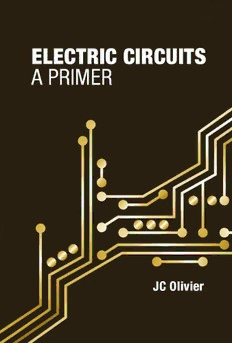Table Of ContentCircuits
This resource provides a comprehensive and concise introduction E ELECTRIC CIRCUITS
to the underpinnings and fundamentals of electrical circuits.
L
Models, the limitations of models, and examples are clearly
explained. The book examines circuits with static sources and E
A PRIMER
explains how to reduce any circuit to a system of linear equations.
C
Dynamic sources that exhibit transient phenomena that require
the solution of linear differential equations are presented. MATLAB® T
code is used throughout the book to help solve key problems and R
assist engineers in the field.
I
Moreover, this hands-on volume explores circuits with sinusoidal C
sources also known as the AC paradigm. The Thevenin and Norton
equivalent models are introduced in order to simplify circuits and
C
demonstrate design for optimal power transfer. The book presents
another key tool known as a phasor, which is a mathematical I
R
construct based on complex number theory. Making use of phasor
theory, the book emphasizes solutions for computing power, C
interpreting power and energy, and compensating electrical systems
U
if the power factor is too low. Professionals are offered design
guidance throughout the book with many real-world examples. I
T
S
JC Olivier is currently a professor of engineering at the University of
Tasmania, Hobart, Australia. He received his B.Eng., M.Eng., and Ph.D.
in electronics engineering from the University of Pretoria, RSA. A
P
R
I
M
E
R
Include bar code O
l
i
v
ISBN 13: 978-1-63081-549-3
i
ISBN: 1-63081-549-7 e JC Olivier
r
ARTECH HOUSE
BOSTON I LONDON
www.artechhouse.com
PMS BLACK PMS 110
Electric Circuits
A Primer
Electric Circuits
A Primer
JC Olivier
OOlliivviieerr__FFMM..iinndddd iiiiii 22//2288//22001188 1111::0011::0000 AAMM
Library of Congress Cataloging-in-Publication Data
A catalog record for this book is available from the U.S. Library of Congress.
British Library Cataloguing in Publication Data
A catalogue record for this book is available from the British Library.
Cover design by John Gomes
ISBN 13: 978-1-63081-549-3
© 2018 ARTECH HOUSE
685 Canton Street
Norwood, MA 02062
All rights reserved. Printed and bound in the United States of America. No part of this book
may be reproduced or utilized in any form or by any means, electronic or mechanical, including
photocopying, recording, or by any information storage and retrieval system, without permission
in writing from the publisher.
All terms mentioned in this book that are known to be trademarks or service marks have been
appropriately capitalized. Artech House cannot attest to the accuracy of this information. Use of
a term in this book should not be regarded as affecting the validity of any trademark or service
mark.
10 9 8 7 6 5 4 3 2 1
Contents
Preface xiii
I StaticCircuitsandKirchhoff’sLaws 1
Chapter1 StaticFields,Energy,andPower 3
1.1 PotentialEnergyConcepts 3
1.2 AnElectricField:PotentialSourceModel 5
1.2.1 AConductor 6
1.2.2 DefinitionofaVoltage 7
1.2.3 PathIndependence 9
1.2.4 ChargedParticlesinMotion:Current 10
1.2.5 CurrentSource 11
1.2.6 PowerandEnergy 11
1.2.7 PassiveSignConvention 12
1.2.8 ConservationofPower 13
1.3 Example:ConservationofEnergyandPower 13
1.3.1 DemonstrationofConservationofPower 15
1.4 Discussion 15
Chapter2 ElectricalCircuitsandCircuitElements 17
2.1 TheResistor 17
2.2 ConceptofaNode 18
2.3 DependentVoltageandCurrentSources 20
2.3.1 AModelfortheBipolarJunctionTransistor 20
2.3.2 TheOperationalAmplifier 22
2.4 Discussion 22
Chapter3 Kirchhoff’sLoopandCurrentLaws 23
3.1 ConceptofaLoop:Kirchhoff’sLoopLaw 24
3.2 SeriesandParallelCircuitElements 25
3.3 ConservationofCharge:Kirchhoff’sNodalorCurrentLaw 26
3.4 SeriesResistorsandVoltageDivision 26
3.5 ParallelResistorsandCurrentDivision 28
3.6 Discussion 30
v
vi ElectricCircuits:APrimer
Chapter4 TheNodalMethodofCircuitAnalysis 31
4.1 ChoosingthePotentialsintheCircuit 31
4.2 ChoosingtheCurrents 33
4.3 Applying the Kirchhoff Loop Law, Kirchhoff Current Law,
andOhm’sLaw 33
4.3.1 TheKirchhoffLoopLaw 33
4.3.2 Ohm’sLaw 34
4.3.3 TheKirchhoffCurrentLaw 34
4.3.4 MathematicalSolution 35
4.3.5 PowerConsumedandDeliveredintheCircuit 37
4.4 SoftwareforCircuitAnalysis 37
4.4.1 Octave 38
Chapter5 CombiningIndependentandDependentSources 39
5.1 AWorkedExample 39
5.2 Discussion 42
Chapter6 FixedPotentialBetweenNodes:Supernode 43
6.1 ACircuitContainingaSupernode 43
Chapter7 TheMeshMethodforCircuitAnalysis 47
7.1 AnExampleoftheApplicationoftheMeshMethod 47
7.2 Supermesh:CurrentSourceinCommon 49
7.3 Discussion 51
Chapter8 Linearity,Superposition,andEquivalence 53
8.1 UsingSuperposition:AnalyzeaCircuit 54
8.1.1 TurnofftheCurrentSource(Sourcewith0Amps) 55
8.1.2 TurnoffthePotentialSource(Sourcewith0Volts) 55
8.1.3 CombineTwoSeparateSolutions 55
8.2 Equivalence 56
8.3 Discussion 59
Chapter9 TheveninandNortonEquivalentCircuits 61
9.1 TheTheveninModel 61
9.2 ComputingtheTheveninEquivalentModel 62
9.2.1 TheveninPotentialV 62
TH
9.2.2 TheveninResistance R 64
TH
9.3 TheNortonModel 65
9.4 ASecondExample 66
9.5 Comments 68
Chapter10 MaximumPowerTransfer 69
10.1 MaximumPowerTransferTheorem 69
Contents vii
10.2 AnExample:MaximumPowerTransfer 71
10.3 Comments 73
II DynamicSources,EnergyStorage,andTransients 75
Chapter11 TheCapacitorandtheInductor 77
11.1 TheCapacitor 77
11.1.1CapacitorsinSeriesandParallel 81
11.2 Inductor 81
11.2.1InductorsinSeriesandParallel 83
11.3 CommentsandSummary 83
Chapter12 TheSource-FreeRCCircuit 85
12.1 TheSource-FreeRCCircuitPrototype 85
12.2 AFirstSource-FreeRCCircuitExample 87
12.3 ASecondSource-FreeRCCircuitExample 88
12.3.1TheCircuitforNegativeTime 88
12.3.2TheCircuitforPositiveTime 89
12.4 AThirdSource-FreeRCCircuitExample 90
12.4.1TheCircuitforNegativeTime 92
12.4.2TheCircuitforPositiveTime 92
12.5 Comments 94
Chapter13 TheSource-FreeRLCircuit 95
13.1 TheSource-FreeRLCircuitPrototype 95
13.2 AFirstExampleofaSource-FreeRLCircuit 96
13.2.1TheRLCircuitforNegativeTime 97
13.2.2TheRLCircuitforPositiveTime 98
13.3 SecondExampleofaSource-FreeRLCircuit 99
13.4 Comments 102
Chapter14 StepResponseofanRCCircuit 105
14.1 TheStepResponseRCCircuitPrototype 106
14.2 NegativeTimeCircuitandItsAnalysis 106
14.3 PositiveTimeCircuitandItsAnalysis 107
14.4 NumericalSolutionBasedonMATLAB 109
14.4.1NumericalSolution 110
14.4.2NumericalResults 112
Chapter15 Examples:StepResponseofanRCCircuit 113
15.1 AFirstExample 113
15.1.1SimplificationandthePrototypeForm 113
viii ElectricCircuits:APrimer
15.1.2SolutionBasedontheSimplifiedCircuit 114
15.2 ASecondExample 116
15.2.1TheNegativeTimeCircuit 117
15.2.2ThePositiveTimeCircuit 118
15.3 Discussion 119
Chapter16 StepResponseofanRLCircuit 121
16.1 NegativeTime 122
16.2 PositiveTime 122
16.3 Discussion 122
Chapter17 Examples:StepResponseofRLCircuits 125
17.1 AFirstExample:StepResponseRLCircuit 125
17.1.1NegativeTimeCircuit 125
17.1.2PositiveTimeCircuit 126
17.1.3TheSolutionfori(t) 126
17.2 ASecondExample:StepResponseRLCircuit 127
17.2.1TheNegativeTimeCircuit 127
17.2.2ThePositiveTimeCircuit 128
Chapter18 SeriesRLCSource-FreeCircuits 131
18.1 SeriesRLCPrototype 132
18.2 SolutionoftheSecondOrderDE 133
18.2.1∆isReal:TheOverdampedCase 134
18.2.2∆isImaginary:TheUnderdampedCase 134
18.2.3∆=0:TheCriticallyDampedCase 134
18.3 NumericalSolutionUsingMATLAB 135
18.3.1Results 137
18.4 Appendix:SolutionofSecondOrderDE 139
Chapter19 Examples:SeriesRLCSource-FreeCircuits 143
19.1 AFirstExample 143
19.1.1NegativeTimeCircuit 144
19.1.2PositiveTimeCircuit 145
19.1.3Discussion 146
19.2 ASecondExample 146
19.2.1TheCircuitforNegativeTime 147
19.2.2TheCircuitforPositiveTime 147
19.2.3Discussion 148
Chapter20 Source-FreeParallelRLCCircuits 149
20.1 SolutionoftheSecondOrderDE 150
20.1.1∆isReal 151
Contents ix
20.1.2∆isImaginary 151
20.2 Discussion 151
Chapter21 ExamplesforaParallelRLCCircuit 153
21.1 AFirstExample 153
21.2 ASecondExample 154
21.2.1NegativeTimeCircuit 155
21.2.2PositiveTimeCircuit 156
21.3 TheUseofCircuitSimulators 157
III AC:SinusoidalVoltageandCurrentSources 159
Chapter22 SinusoidalSources,thePhasorandImpedance 161
22.1 TheTheoryofthePhasor 162
22.1.1AResistorUsingthePhasorNotation 163
22.2 TimetoPhasorDomainTransformation 165
22.3 ACapacitorUsingthePhasor:Impedance 166
22.4 AnInductorUsingthePhasor:Impedance 168
22.5 Discussion 170
Chapter23 CircuitAnalysisBasedonPhasorDomainRepresentation 171
23.1 AFirstExample 171
23.1.1PhasorDomainAnalysis 173
23.1.2Discussion 173
23.2 ASecondExample 174
23.3 Comments 176
Chapter24 DependentandIndependentSources:PhasorDomain 177
24.1 AFirstExample 177
24.2 ASecondExample 179
24.3 Comments 180
Chapter25 Superposition:Phasors 181
25.1 AnalysisBasedontheACPotentialSource 182
25.2 AnalysisBasedontheACCurrentSource 183
25.3 AnalysisBasedontheStaticVoltageSource 185
25.4 ApplyingSuperpositionintheTimeDomain 186
25.5 Comments 186
Chapter26 TheMaximumPowerTransferTheoremandResonance 187
26.1 Thevenin’sTheoremforACCircuits 187
26.1.1TheveninPotential 188
26.1.2TheveninImpedance Z 189
TH

